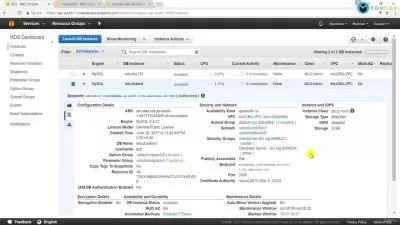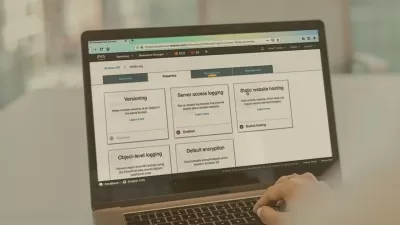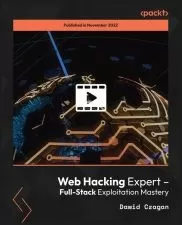Penetration Testing and Red Teaming on AWS
Gopi Narayanaswamy
6:40:12
Description
Exploit and Assess AWS Cloud Environment
What You'll Learn?
- Gain a solid understanding of cloud computing concepts, including the advantages and challenges of cloud-based solutio
- Acquire fundamental knowledge about Amazon Web Services (AWS), its core services, and its role in cloud computing.
- Explore the essentials of cloud security, including key technologies and services designed to safeguard cloud data and infrastructure from cyber threats.
- Learn how the shared security responsibility model works and grasp the roles and responsibilities of both AWS and the customer in securing cloud environments.
- Develop the ability to recognize and assess the various attack surfaces within AWS cloud environments, identifying potential vulnerabilities and risks.
- Acquire the skills and knowledge required to conduct red team activities, simulating real-world threats and enhancing your penetration testing expertise.
- Learn how to assess and improve the configuration and security posture of both internal and external cloud resources, such as virtual machines, storage buckets,
- Master advanced penetration testing techniques, tools, and methodologies, and apply them to assess and secure cloud environments effectively.
- This course equips students with the foundational knowledge and practical skills required to navigate the complex landscape of cloud security within AWS, helpin
Who is this for?
What You Need to Know?
More details
DescriptionIn an age of increasingly sophisticated cyber threats, safeguarding cloud environments, like AWS (Amazon Web Services), is paramount. This comprehensive course is meticulously crafted to arm you with the knowledge and skills necessary to fortify AWS environments and undertake penetration testing and red teaming endeavors. By delving deep into AWS security essentials, understanding shared security responsibilities, and mastering advanced penetration testing techniques, you will emerge well-equipped to shield AWS cloud ecosystems and uncover vulnerabilities before malicious adversaries can exploit them.
Course Content:
Understanding Cloud and AWS Services: Begin your journey with a solid foundation in cloud computing and a comprehensive grasp of the AWS ecosystem.
What are the AWS Security Services: Explore AWS's array of security services designed to protect cloud resources.
Shared Security Responsibilities in AWS: Uncover the core principles of shared security responsibilities, emphasizing the roles AWS plays in securing the cloud, and your role in securing your applications and data.
Understanding the Attack Surfaces: Navigate the vast attack surfaces in AWS cloud, identifying potential vulnerabilities and risks.
Assess/ Red Teaming of External Assets: Develop the skills to assess and engage in red teaming activities for external assets, simulating real-world threats.
Advanced Penetration Testing Techniques: Elevate your penetration testing expertise with advanced tactics, tools, and methodologies.
Exploitation and Assessment of AWS Services: Deep dive into the evaluation and exploitation of various AWS services, including IAM, S3, RDS, Lambda, CloudFront, API Gateway, WAF, EC2, and CI/CD security.
Practical Demonstrations and More: Apply your knowledge through hands-on exercises and practical demonstrations, cementing your understanding of AWS security.
Outcome:
Upon successful completion of this program, you will be empowered with the expertise to effectively secure AWS environments, perform penetration testing, and orchestrate red teaming exercises. With the ability to assess and pinpoint vulnerabilities across a spectrum of AWS services, you will significantly enhance your skills as a cybersecurity professional. Prepare to be a formidable guardian of AWS cloud resources, equipped to thwart threats and bolster security in the ever-evolving digital landscape.
Who this course is for:
- Cyber Security professionals, Cloud Security engineers and Cloud administrator
In an age of increasingly sophisticated cyber threats, safeguarding cloud environments, like AWS (Amazon Web Services), is paramount. This comprehensive course is meticulously crafted to arm you with the knowledge and skills necessary to fortify AWS environments and undertake penetration testing and red teaming endeavors. By delving deep into AWS security essentials, understanding shared security responsibilities, and mastering advanced penetration testing techniques, you will emerge well-equipped to shield AWS cloud ecosystems and uncover vulnerabilities before malicious adversaries can exploit them.
Course Content:
Understanding Cloud and AWS Services: Begin your journey with a solid foundation in cloud computing and a comprehensive grasp of the AWS ecosystem.
What are the AWS Security Services: Explore AWS's array of security services designed to protect cloud resources.
Shared Security Responsibilities in AWS: Uncover the core principles of shared security responsibilities, emphasizing the roles AWS plays in securing the cloud, and your role in securing your applications and data.
Understanding the Attack Surfaces: Navigate the vast attack surfaces in AWS cloud, identifying potential vulnerabilities and risks.
Assess/ Red Teaming of External Assets: Develop the skills to assess and engage in red teaming activities for external assets, simulating real-world threats.
Advanced Penetration Testing Techniques: Elevate your penetration testing expertise with advanced tactics, tools, and methodologies.
Exploitation and Assessment of AWS Services: Deep dive into the evaluation and exploitation of various AWS services, including IAM, S3, RDS, Lambda, CloudFront, API Gateway, WAF, EC2, and CI/CD security.
Practical Demonstrations and More: Apply your knowledge through hands-on exercises and practical demonstrations, cementing your understanding of AWS security.
Outcome:
Upon successful completion of this program, you will be empowered with the expertise to effectively secure AWS environments, perform penetration testing, and orchestrate red teaming exercises. With the ability to assess and pinpoint vulnerabilities across a spectrum of AWS services, you will significantly enhance your skills as a cybersecurity professional. Prepare to be a formidable guardian of AWS cloud resources, equipped to thwart threats and bolster security in the ever-evolving digital landscape.
Who this course is for:
- Cyber Security professionals, Cloud Security engineers and Cloud administrator
User Reviews
Rating
Gopi Narayanaswamy
Instructor's Courses
Udemy
View courses Udemy- language english
- Training sessions 160
- duration 6:40:12
- Release Date 2023/12/07















